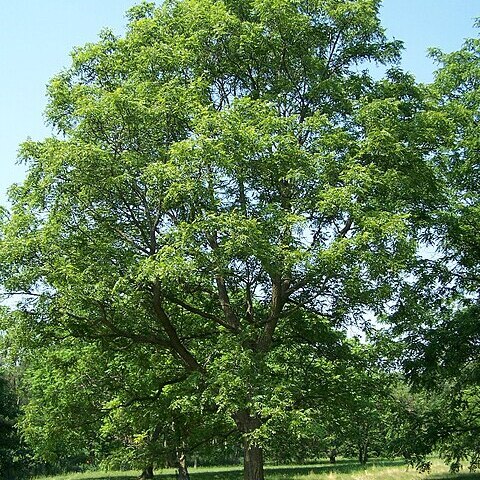Trees or rarely shrubs, deciduous, monoecious. Branchlets with chambered pith. Terminal buds with false-valved scales. Leaves odd-pinnate; leaflets 5-31, margin serrate or rarely entire. Inflorescences lateral or terminal on old or new growth; male spike separate from female spike, solitary, lateral on old growth, pendulous; female spike terminal on new growth, erect. Flowers anemophilous. Male flowers with an entire bract; bracteoles 2; sepals 4; stamens usually numerous, 6-40, anthers glabrous or occasionally with a few bristly hairs. Female flowers with an entire bract adnate to ovary, free at apex; bracteoles 2, adnate to ovary, free at apex; sepals 4, adnate to ovary, free at apex; style elongate with recurved branches; stigmas carinal, 2-lobed, plumose. Fruiting spike erect or pendulous. Fruit a drupelike nut with a thick, irregularly dehiscent or indehiscent husk covering a wrinkled or rough shell 2-4-chambered at base. Germination hypogeal.
Staminate catkins protruding from the buds in autumn, elongating in spring, densely fld, pendulous; bract adherent to the “perianth,” except at its summit; “perianth “ spreading, 3–6-lobed, with 8–40 stamens on its upper side; anthers glabrous; pistillate fls in short spikes terminating the branches, closely subtended by a 3-lobed, cup-shaped involucre that ripens with the fr to form a husk; perianth minute, 4-parted; husk indehiscent, clammy-glandular; nut indehiscent but ± distinctly 2-valved; trees with partitioned pith and odd-pinnate lvs, the median-lateral lfls the largest, inequilateral or falcate; lfls with conduplicate vernation. 20, widespread.
Trees; bark fissured. Twigs with lamellate pith. Winter buds with few scales. Lvs aromatic. ♂ catkins pendulous, solitary, situated laterally on previous year's shoots. ♀ fls terminal, few or solitary, in erect spikes. Bracteoles adnate to ovary, not persistent. Fr. a large indehiscent drupe; endocarp woody and often very hard, incompletely 2-4-celled, indehiscent or dividing in 1/2. Seed corrugated, 2-4-lobed, remaining in shell at germination.

